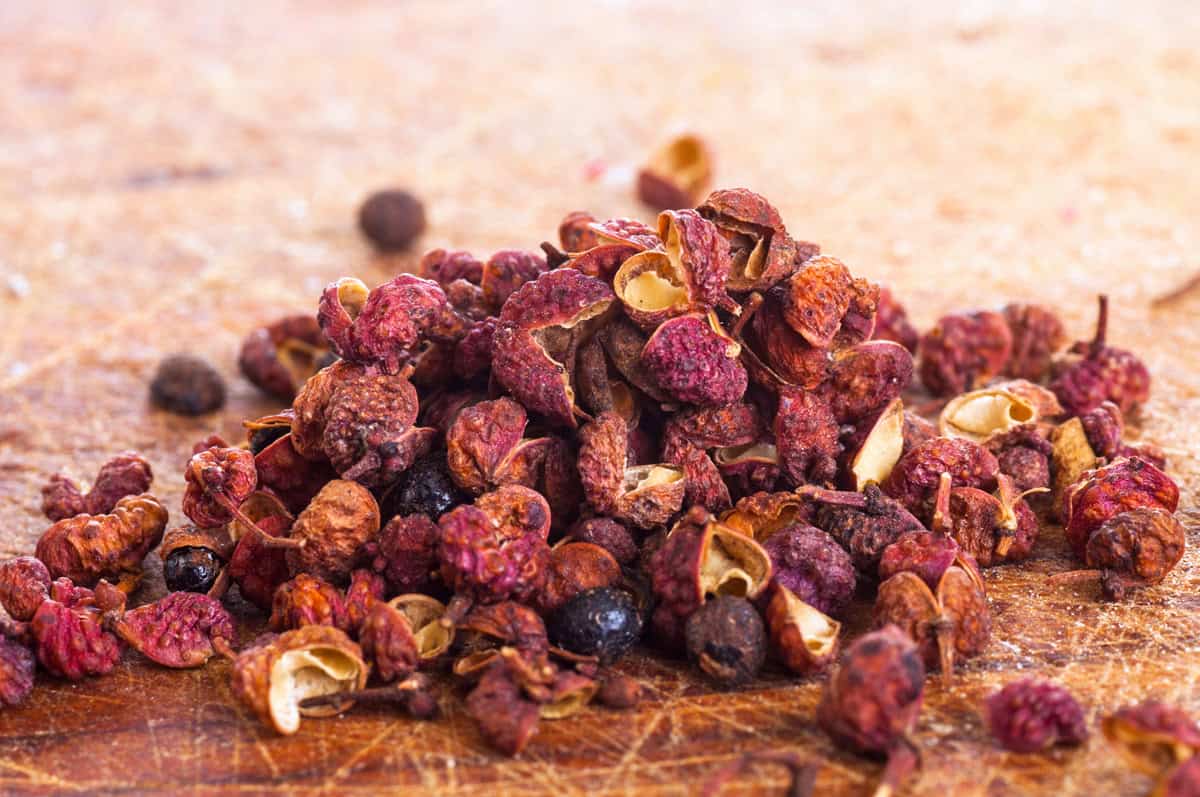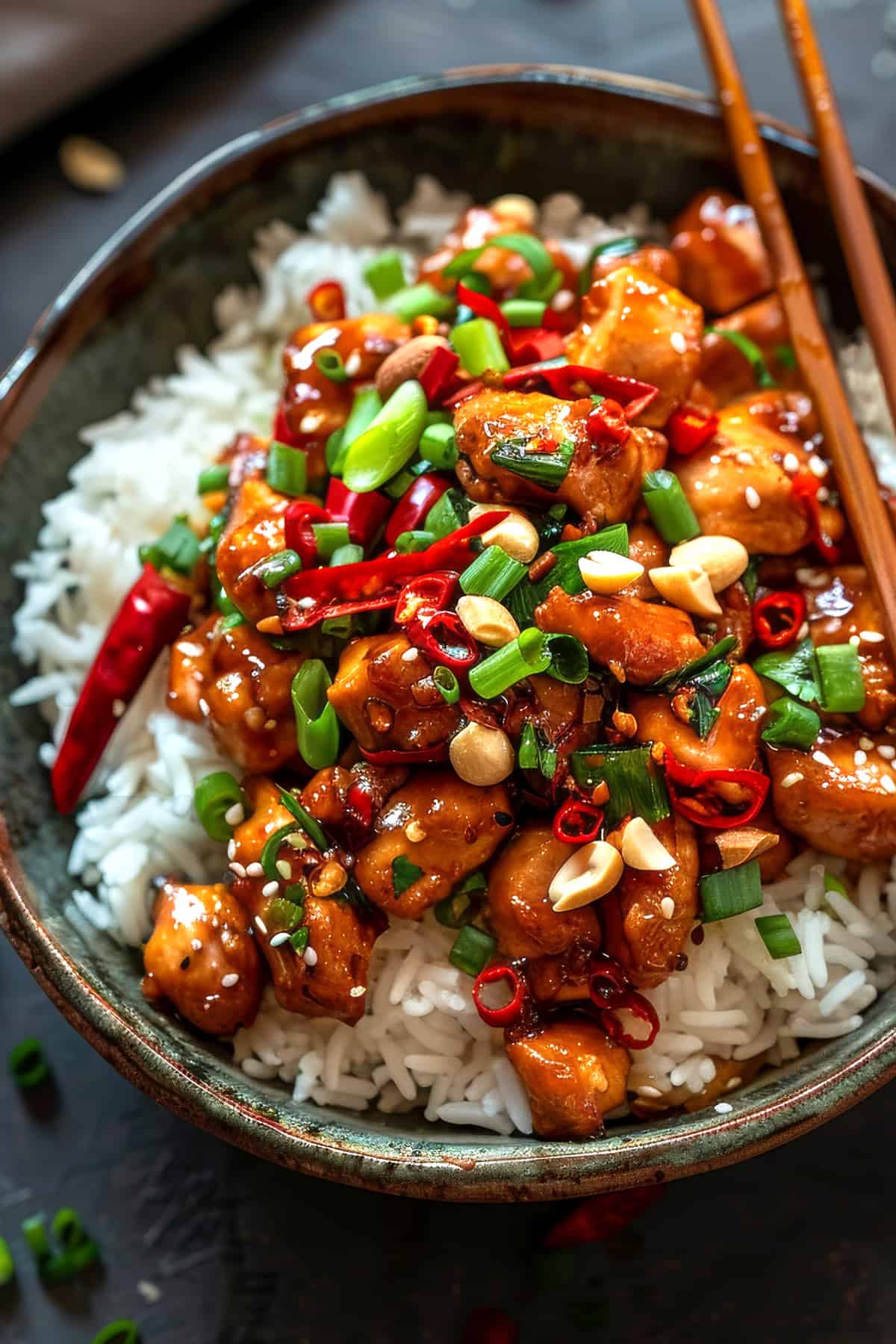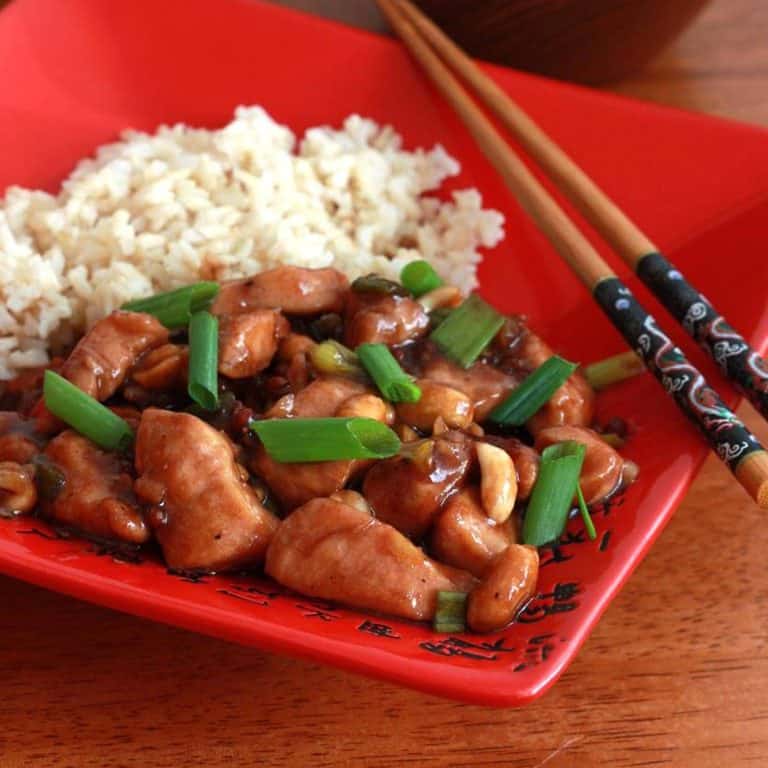Kung Pao Chicken
This post may contain affiliate links. See my disclosure policy.
Authentic and thoroughly delicious, this Kung Pao Chicken rivals your favorite takeout or restaurant version and is super quick to make! And get ready to brace yourself because this dish packs a PUNCH! And if you’re looking for a meatless alternative, I include instructions for making a delicious Kung Pao Tofu!

This is one of our favorite Chinese dishes to order out. But more often than not I’ll make it myself at home because when it’s this quick and easy to make, there’s practically no excuse not to. And not to mention it tastes SO much better and fresher homemade!
What is Kung Pao Chicken?
Kung Pao Chicken is a spicy, stir-fried Chinese dish that is made with bite-sized pieces of chicken, peanuts, chili peppers, and Sichuan peppercorns. It is a popular Chinese takeout dish in many areas of the world. It originated in the Szechuan province of China and is popular both throughout China and the Western world. It’s believed to have been named after the governor of Szechuan, Ding Baozhen of the Qing Dynasty. His official title, Gong Bao (meaning “palatial guardian”), is thought to have inspired the name of the dish (“Bao” became “Pao”). The name “Kung Pao” continued until the Cultural Revolution when any association with Ding Baozhen became politically incorrect. At that point the name of the dish was changed to simply “fast-fried chicken cubes” or “chicken cubes with seared chiles” until the 1980′s when the political climate cooled and it’s original name of Kung Pao Chicken was reclaimed.
And so it remains today as one of the most popular of all Chinese dishes. Not for the faint of tastebuds, this dish packs a punch, or I should say “PAO!”

What Are Sichuan Peppercorns?
The key component to authentically-tasting Kung Pao is the use of whole sichuan/szechuan peppercorns. They’re commonly used in authentic Asian cuisine but far less known in Chinese-American cooking. That’s largely because it was banned from importation to the U.S. from 1968 until 2005, being viewed as a potential carrier of “citrus canker,” a tree disease that can potentially harm citrus crops. The ban was lifted in 2005 and we now have access to this distinct and delicious ingredient.
Not actually a peppercorn or even related to the pepper family at all, the sichuan peppercorn is part of the citrus family and its flavor bears some subtle nuances to its genus. It is one of the ingredients in Chinese Five Spice Powder, and is also traditionally used in Chinese medicine. Sichuan peppercorns have an extraordinarily unique flavor and there are no substitutes.
Highly flavorful and fragrant, szechuan peppercorns impart a tingling numbness that enriches fiery tastes. You can find them in well-stocked Asian grocery stores or order sichuan peppercorns online.

Kung Pao Tofu Recipe
Before we get to our Kung Pao Chicken recipe, for anyone interested in a meatless alternative, you simply substitute the chicken for one batch of our homemade Baked Tofu. Marinate the baked tofu as you would the chicken, add the tofu at the same time as adding the green onions, garlic, and ginger, and proceed with the recipe as directed.
Kung Pao Chicken Recipe
To make Kung Pao Chicken you’ll need to:
- Combine the vinegar, soy sauce, hoisin sauce, sesame oil, sugar, and cornstarch in a small bowl. Stir until the sugar and cornstarch are dissolved. Set aside.
- Heat a wok or large skillet over high heat until a drop of water sizzles when thrown in. Add the oil and coat the bottom of the pan. Add the chilies and sichuan peppercorns and stir-fry for about 30 seconds until the chilies begin to darken in color, but be careful not to burn them.
- Add the chicken along with the juices from the marinade and fry until the chicken is no longer pink.
- Add the white parts of the green onion along with the garlic and ginger and stir-fry for another 30 seconds. Pour in the sauce and stir, coating the chicken. Add the peanuts, stir to coat, and cook for another 2 minutes.
It’s that simple and it’s that quick! Serve your Kung Pao Chicken with some steamed rice and garnish with the sliced green parts of the green onions and some extra peanuts.
Enjoy!

For more favorite Chinese recipe try my:
- Mongolian Beef
- Mongolian Chicken
- General Tso’s Chicken
- Biang Biang Noodles
- Sesame Chicken
- Orange Chicken
- Orange Beef
- Egg Foo Young
- Shanghai Noodles
- Chinese Beef and Broccoli
- Hot and Sour Soup
Save This Recipe

Kung Pao Chicken
Ingredients
- 1 pound skinless, boneless chicken breasts or thighs , cut into 3/4-inch cubes
- or Baked Tofu for vegetarian option (click link for recipe and see instructions below in Note)
- 2 tablespoons peanut or extra virgin olive oil
- 8 to 10 dried red chilis , broken up in large pieces, seeds and membranes carefully removed and discarded
- 5 green onions , sliced, the green and white parts kept separate
- 3 cloves garlic , minced
- 2 teaspoons fresh ginger , minced
- 1/2 cup unsalted dry-roasted peanuts
- Marinade:
- 1 tablespoon tamari or soy sauce
- 2 teaspoons Chinese rice wine , or dry sherry
- 1/2 teaspoon cornstarch
- Sauce:
- 1/4 cup Chinese black vinegar , or substitute good-quality balsamic vinegar
- 1 1/2 tablespoons soy sauce
- 1 1/2 tablespoons hoisin sauce
- OR Best Homemade Hoisin Sauce (click link for recipe)
- 1 1/2 tablespoons toasted sesame oil
- 2 tablespoons sugar
- 2 teaspoons cornstarch
- 1 1/2 tablespoons whole Sichuan peppercorns
Instructions
- In a medium bowl, stir together the soy sauce, rice wine, and cornstarch until the cornstarch is dissolved. Add the chicken and toss to coat and let it marinate for at least 10 minutes.In a small bowl, combine the vinegar, soy sauce, hoisin sauce, sesame oil, sugar, and cornstarch. Stir until the sugar and cornstarch are dissolved. Set aside.
- Heat a wok or large skillet over high heat until a drop of water sizzles when thrown in. Add the oil and coat the bottom of the pan. Add the chilies and szechuan peppercorns and stir-fry for 30 seconds until the chilies begin to darken in color but be careful not to let them burn. Add the marinated chicken and stir-fry until no longer pink.Add the white parts of the green onion along with the garlic and ginger and stir-fry for another 30 seconds. Pour in the sauce and stir, coating the chicken. Add the peanuts, stir to coat, and cook for another 2 minutes.
- Transfer to a dish, sprinkle the green parts of the green onions on top, and serve immediately with rice.
Notes
Nutrition
Originally published on Daring Gourmet October 12, 2015. See earlier image below.




















Looks pretty awesome but, you’re missing one key step in making it authentic and delicious – velveting the chicken meat before stir-frying. You do that, this becomes godly.
Velveting is rather godly, I agree! :) I velvet the chicken in my Chinese Orange Chicken but most Kung Pao I’ve seen in restaurants and have had served by Chinese friends isn’t velveted. It’s probably just a matter of personal preference.
It looks delicious, but could you please tell me how many calories there would be per serving? Since I’m currently on a weight loss plan, it would be helpful to know the nutrition information. Thank you!
Hi Nikki, I haven’t calculated that information but there are several sites, like fitday.com, where you can enter the ingredients and it gives you the nutritional breakdown. If you’re on a weight loss program though I wouldn’t recommend this or anything with a good amount of sugar in it.
I love it
Thank you!
My family did not like this recipe.
Sorry you didn’t like it, EH. Have you had kung pao chicken before so you’d know what to expect? This is very similar to what you’ll find in the best Chinese restaurants and many readers have told me it’s even better. It’s one of our favorites. But it is very spicy!
I made this dish tonight. It was fantastic to say the least. We served it with rice and stir fried sweet peppers and I made a papaya coconut whip for dessert. it was a really nice gluten free menu. Thanks for the Asian peppercorn explanation.
Fantastic, so happy to hear it was a hit! The papaya coconut whip sounds like the perfect follow-up to a spicy meal.
My husband loved this so much that I made it twice in the same weekend. I have tried quite a few Asian recipes, but this is the best ever! Thanks so much!
You’ve made my day, Leah, thank you! :)
Loved it♡♡♡
Fantastic, aderline!! So thrilled it was a success and thanks for the feedback!
I am adding this to my March 2013 menu that will be available as a free printable with a hyperlink back to your website. Thank you so much for helping me prepare my menu. :)
Thank you for the compliment, Penny. I’m honored to be part of your March menu line-up and look forward to seeing what other goodies you include. Thanks for visiting.